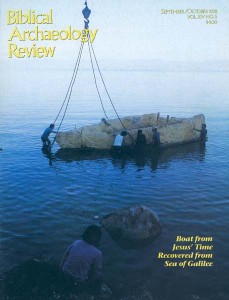How Old Is the Galilee Boat?
Sidebar to: The Galilee Boat—2,000-Year-Old Hull Recovered Intact
The Galilee boat has been dated by a method called radiocarbon dating. This method could be used because the boat was made of wood, a carbon-containing material.
To understand radiocarbon dating, it’s important to understand some basic facts about the world of nature. Carbon in the atmosphere exists in three forms—called isotopes—that differ in the weight of their atoms but not in their chemical behavior, so organisms use them as if they were exactly the same. The most abundant form is carbon 12, but for every 1012 atoms of carbon 12 there is one atom of the heaviest form, radioactive carbon 14. Carbon 14 is constantly being produced in the atmosphere.
To say that carbon 14 is radioactive means that it decays to the stable, non-radioactive nitrogen at a constant rate. This decay accounts for the fact that the number of carbon-14 atoms in the atmosphere and in living organisms, which continuously exchange carbon with the atmosphere as part of the biological processes of life, does not increase without limit but remains approximately constant.
As long as an organism is alive, the carbon within it is composed of the same proportion of carbon 12 and carbon 14 as the carbon in the atmosphere. But when an organism dies, such as a tree cut for use of its wood, the exchange process stops and decay of carbon 14 proceeds without any replenishment of the supply from the atmosphere.
Already a library member? Log in here.
Institution user? Log in with your IP address.

